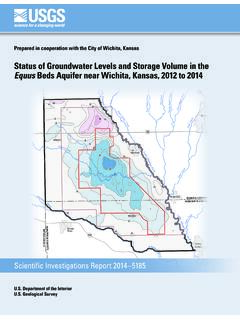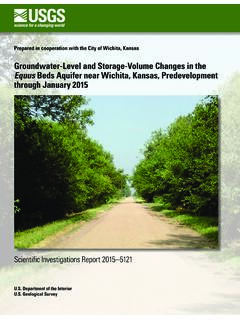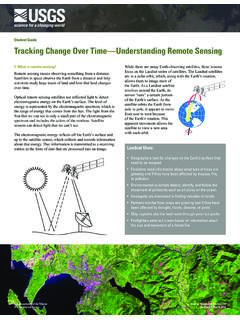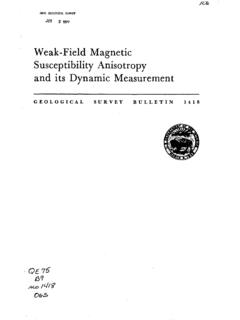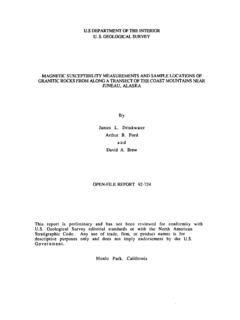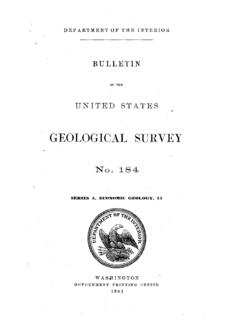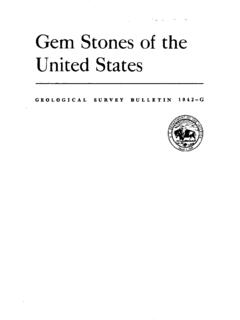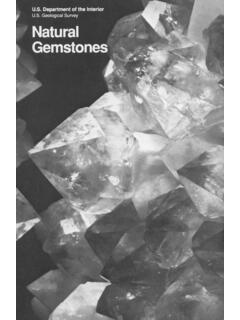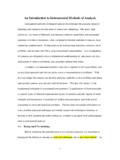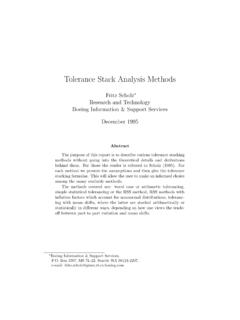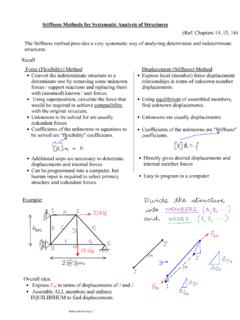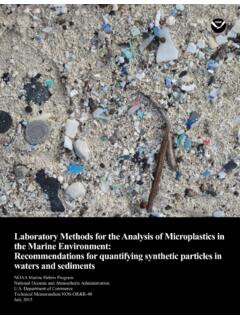Transcription of Methods for Collection and Analysis of Water Samples - USGS
1 WRD LIBRARY COPY U. S. GEOLOGICAL SURVEYM ethods for Collection and Analysis of Water SamplesGEOLOGICAL SURVEY Water -SUPPLY PAPER 1454 LIBRARYM ethods for Collection and Analysis of Water SamplesBy F. H. RAINWATER and L. L. THATCHERGEOLOGICAL SURVEY Water -SUPPLY PAPER 1454 UNITED STATES GOVERNMENT PRINTING OFFICE, WASHINGTON : 1960 UNITED STATES DEPARTMENT OF THE INTERIOR STEWART L. UDALL, SecretaryGEOLOGICAL SURVEY Thomas B. Nolan, DirectorThe Geological Survey Library has cataloged this publication as follows:Rainwater, Frank Hays, 1921 Methods for Collection and Analysis of Water Samples , by F. H. Rainwater and L.
2 L. Thatcher. Washington, Govt. Print. Off., , 301 p. illus., diagrs., tables. 24 cm. ( Geological Survey. Water -supply paper 1454) Includes Water Analysis . I. Thatcher, Leland Lincoln, 1923 joint author. II. 19621965 For sale by the Superintendent of Documents, Government Printing Office Washington, , 20402 - Price $ (paper cover)PEEFACEThe Geological Survey has the responsibility for measuring and evaluating Water moving through that portion of the hydrologic cycle between the time the Water from the atmosphere reaches the earth's surface and the time it is returned to the atmosphere or enters the ocean.
3 During this part of the cycle, Water may appear in many environments and under different conditions, and a full understand- ing of the problems of hydrology requires the application of various specialized scientific techniques. The Quality of Water Branch of the Water Kesources Division determines and appraises the chemical and physical characteristics of the Nation's Water activities include (1) systematic Collection , compilation, and evaluation of basic data relating to the chemical and physical quality of surface and ground waters as required for the. develop- ment and utilization of industrial, municipal, and agricultural Water supplies; (2) research and development studies to improve investi- gational techniques; (3) fundamental studies of the occurrence and significance of dissolved and suspended substances; and (4) prepara- tion of results of Water -quality research and investigations for publication.
4 This manual covers only the data- Collection segment of the work between and including the selection of the sampling site and the completion of the laboratory determination of Water char- acteristics attributable to the presence of dissolved material. Other phases of chemical-quality investigations are discussed by J. D. Hem, 1959, in "Study and Interpretation of the Chemical Characteristics of Natural Water ," Geological Survey Water -Supply Paper manual was prepared by the Geological Survey, Water Resources Division, under the immediate supervision of W. F. White, chief, Chemical Quality Section of the Quality of Water Branch.
5 Many associates contributed helpful suggestions and reviewed the analytical _ _--__--_--__-_____-___--___-_-__-_----__ -____-_ inAbstract_ ._____ 1 Section A. Collection of Water 3 Sampling-site selection (A:l)__-_____--____-__--___-_---_--_-_ 3 Selection of surface- Water sampling site (A: la)_____ 3 Selection of ground- Water sampling site (A:lb)_____ 6 Sampling frequency (A:2)_____ 7 Sampling equipment (A:3)_____ 8 Sample containers (A:3a)_____-_____-____-_-_____- 8 Apparatus for sampling Water that contains nonvolatile con- stituents unsusceptible to aeration (A:3b)_____ 10 Apparatus for sampling Water that contains dissolved gases andconstituents susceptible to aeration (A: 3c) _____ 13 Sampler suspension apparatus (A:3d)_____ 15 Sampling instructions (A.)
6 4) 15 Safety precautions (A:4a)_____ 15 Collection of representative Samples (A:4b)_____-___---___-__ 20 Tabulation of sample data (A:4c)_____ 20 Special treatments, preservatives, and fixation (A:4d)_____ 27 Section B. Handling of Water Samples before 31 Time between sample Collection and Analysis (B:l)_____-_____ 31 Sample-bottle cases (B:2)--_____--__--_-_----------_--_----- --- 32 Sample storage (B:3) 32 Preparation of composite Samples (B:4)_____ 32 Time-weighted composite Samples (B:4a)_____ 36 Discharge-weighted composite Samples (B:4b)_____ 37 Removal of turbidity (B:5)_____-_-__--__----____--_-----_---- _ 39 Section C.
7 Analysis of Water samples_____ 43 Analytical techniques in Water Analysis (C:l)_____ 43 Spectrophotometry (C:la)_____ 43 Terminology and procedures (C:la-1) _____ 44 Applications of Spectrophotometry to Water Analysis (C:la-2)--_____-___-___---_____- --__---_----------_ 47 Flame photometry (C:lb)_____ 55 Instruments (C:2)____--_____---___-----_----_---_ 58 Conductivity meters (C:2a) ___-__--___--___-__-__---__----_ 58 Balances (C:2b)_____-_____--_-_-_- 60pH meters (C:2c) 60 Spectrophotometers (C:2d)_____ 61 Flame photometers (C:2e)_____-____-_---_--_------ 68 Water -color comparators (C:2f)_____ 69 Turbidimeters (C:2g) 70 Photometric titration assemblies (C:2h)_____-_____---- 71 Glassware and other containers used in the laboratory (C: 3) -------- 72 Choice of analytical Methods (C:4)_____-_-_____--_-----_ 75 Explanation of terminology (C:5) 75vVI CONTENTSS ection C.
8 Analysis of Water Samples Continued PageScheme of Analysis (C: 6) _____--___---__-_____ 78 Significant figures for reporting results (C:7)_____ 79 Evaluation of the accuracy of analytical results (C:8)_____ 81 Chemical balance (C:8a)_____ 81 Relation of residue on evaporation to calculated dissolved solids(C:8b)_____ 83 Specific-conductance relation (C:8c)_____--_---__--____ 84 Interrelation of constituents of Water from the same source(C:8d)_____ 85 Method for checking partial analyses (C:8e)_____ 86 Section D. Analytical procedures_____ 87 Acidity (D:!)_____ 87 Total acidity (D:la)_____ 88 Volumetric method (D:la-l)__-----------------------_- 88 Immediate acidity (D:lb)_____ _____ 90 Volumetric method (D: lb-l)_____---_____ 90 Potential free acidity (D:lc)__-___--___---__----_--------___ 91 Volumetric method (D:lc-l)_____-_-_-_-_---____ 91 Alkalinity (D:2)_____ 93 Potentiometric method (D:2a-l)_____ 94 Aluminum (D:3)____-___-_-_____-_-_-_____-__---_-- -_---_-__- 97 Ferron-orthophenanthroline method (D:3a-l)^_____ 97 Arsenic (D:4)_____ 101 Gutzeit-volumetric method (D:4a-l)_____ 101 Barium (D:5)_____ 107 Gravimetric method (D.)
9 5a-l)_____-_---_-_---___-___ 107 Complexometric method (D:5a-2)_-___-_--__-__--------_--__ 109 Boron (D:6)~ __ _____ _ _____ _ ___ _ ____ 113 Dianthrimide method (D:6a-l)_____ 113 Potentiometric method (D:6a-2)_____ 115 Carmine method (D:6a-3)_____-_-_-____--___-_-___ 118 Bromide (D:7)_____ 121 Oxidation method (D:7a-l)_-___----------_---_---_-------- 121 Bromine displacement method (D:7a-2)_____ 124 Calcium (D:8) _ ___ 127 Complexometric method (D:8a-l)_-_-------_-------_-_------ 127 Permanganimetric method (D:8a-2)_____-___---_-- 129 Gravimetric method (D:8a-3)____---------_---_-----_-_---- 131 Turbidimetric method (D:8a-4)_____ 134 Carbon dioxide (D:9)_-_____-__-___-_-_---_-_---__--_-_- ----- 137 Calculation method (D:9a-l)_____-___-_-_-_____ 137 Chloride (D:10)_____ 141 Volumetric method (D: 10a-l)_____ 141 Gravimetric method (D:10ar-2)___---_---------------_------ 143 Chlorine residual (D: 11).
10 _____-_____--_----------_- 147 Orthotolidine-arsenite method (D: 1 la-1)_____-_-_----__-___ 147 Chromium (D:12)_____ 151 Hexavalent chromium (D: 12a)__-_-_---_---------_-_-------- 151 Diphenylcarbazide method (D: 12a-l)._____ 151 Chromium (D:12b)_____ 153 Permanganate-azide method (D: 12b-l)_____ 153 CONTENTS VIIS ection D. Analytical procedures Continued PageColor (D:13)_____ 155 Comparison method (D: 13a-l)_____--_--_-__-___--_____ 155 Copper CD:14)_____ 157 Diethyldithiocarbamate spectrophotometric method (D:14a-l)___ 157 Density (D:15)_____ 161 Gravimetric method (D: 15a-l) 161 Fluoride (D:16)_ 163 Zirconium-Eriochrome Cyanine R method (D: 16a-l)_____ 163 Zirconium-alizarin method (D: 16a-2).
